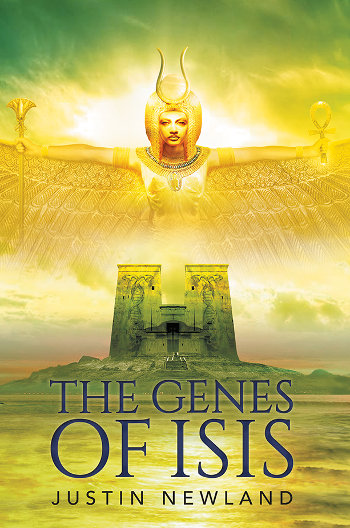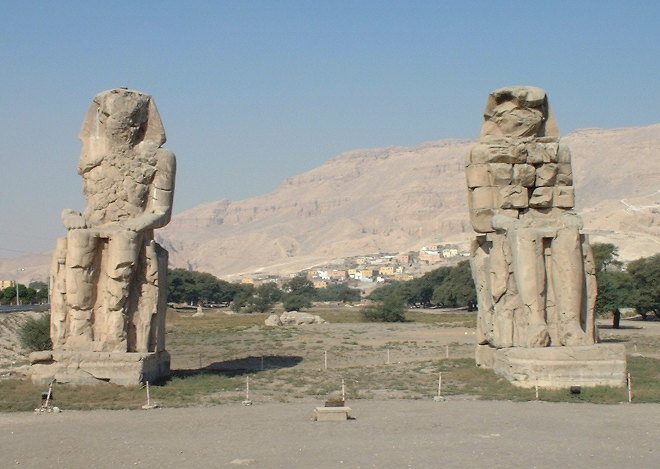 In today’s guest post, author Justin Newland talks us through the ancient stories that helped to inspire his novel Sources of the Genes of Isis.
In today’s guest post, author Justin Newland talks us through the ancient stories that helped to inspire his novel Sources of the Genes of Isis.
I guess I’ve always had an inquiring mind. I wanted to explore our origins. Where did we come from? How did we get where we are today? I wanted to conceive a story that offered the discerning reader a different entry point to these age-old questions.
I began by looking through the glass darkly into the past. I quickly ended up in Ancient Greece, and eventually in Ancient Egypt, the earliest recorded historical culture.
The Ancient Egyptians also imagined their origins though creation myths, of which one is the myth of Osiris. He was king to Isis’ queen. But Set murders Osiris, dismembers him and distributes his body parts all over Egypt. Isis gathers them together, miraculously brings him back to life, and bears him a son, the hawk-headed Horus.
This is a story of life and death, procreation, rebirth and the struggle for power, all of them archetypal themes. And the basic ingredients of the myth are not a bad template for a novel: start, weave the threads, spread them far and wide, then collect them altogether, breathe new life into them for a pulsating climax.
That wasn’t all. Many great men have set their feet upon the path to Egypt: Alexander the Great, Julius Caesar, and Napoleon Bonaparte. It was the first and oldest civilisation, and therefore influenced everything that followed. The first in any field always does. In this respect, Egypt is the Mother and Father of all things.
That set me going.
Explore infinite possibilities
Next up, I discovered legends from other ancient cultures that mentioned cross-breeding between species, of mixed genetics, and hybrids. The apocryphal The Book of Enoch spoke of the Grigori, or ‘fallen angels’, who came to Earth and mated with ‘the daughters of men,’ spawning the Nephilim, an antediluvian race of giants. The Epic of Gilgamesh talked of strange beings such as fish-men, who came ashore for the day, and returned to the sea at night. Even today, you can see a stone carving of such a creature at the Temple of Queen Hatshepsut behind the Valley of the Kings in Egypt. (see above)
These and other sources fired my imagination. What if these ‘fallen angels’ manifested in human form and settled in Ancient Egypt? What if antediluvian genetics were unstable, in that the normal bindings that prevented the existence of crossbreeds had become loosened, spawning mixed genetic creatures and humans with the head of animals?
The germ of the idea for the novel was born: an alternative genesis of the human race.
Interwoven with these threads was esoteric information about such concepts as the astral light and the akashic record, referenced by the Theosophical Society and, more recently, the Emin Society. They conceived of the akashic record as a compendium of thoughts, events, and emotions encoded in a non-physical plane of existence.
This is where I derived the name for the novel’s heroine, Akasha, a Sanskrit word meaning ‘aether’ or atmosphere.
Also mooted was the astral body, a sort of personal spirit entity, which could leave a person (usually during sleep) and travel the astral light, there to explore the akashic record and so re-live any event or person from any time in history. This is what Edgar Cayce, an American mystic, claimed to have done. His profuse and profound writings speak of the time before the Flood.
All this nourished my fascination for the supernatural.
Doris Lessing’s Shikasta contained some original and interesting ideas about how humans may have lived in the times before recorded history.
I got the name Samlios, where the Akasha is born and where the initial action of the novel unfolds, from Gurdjieff’s Beelzebub’s Tales to his Grandson.
Then the Flood. Where did that fit into the story? Now, think about it for a moment. If it rained for 40 days and 40 nights, how did all that water get up there in the first place?
What about this utterance from the Ancient Egyptian Pyramid Texts: ‘I shall cross the great lake in the sky and return home to my double on the sun.’
More recently, Old Mother Shipton, a Yorkshire prophetess, coined her answer: ‘Beneath the water, men shall walk. Shall ride, shall sleep, shall even talk.’
What if the waters were already up there in the sky, and the earth had shrunk like a dried prune, leaving the remaining oceans on narrow and shallow sea beds?
Another element of the world of The Genes of Isis was taking shape.
Build a narrative and characters
With two main sources, I needed two protagonists, one to speak for the humans, and the other for the angels, whom I called the Solarii. I envisaged the embryonic human race as blue-blooded, gentle folk, and kind. The Solarii on the other hand, were drawn as severe, powerful and dedicated.
A comparison of opposites yielded a girl and boy, young and old, Akasha and Horque. The main characters took shape.
 Then in the novel, I twisted another Biblical weave: instead of having the Jews as slaves to the Egyptians, I conceived of them as willing helpers and servants.
Then in the novel, I twisted another Biblical weave: instead of having the Jews as slaves to the Egyptians, I conceived of them as willing helpers and servants.
When I started work on the novel, I began with the idea, a rough storyline, giving me the destination. Then the characters emerged out of the plot and suggested parts they could play. Sometimes I heard their voices when composing the dialogue. Sometimes my imagination revealed things about them, like what they carried in their pockets.
I found my characters crouching behind the plot lines, emerging out of the shadows of the narrative, and in the great halls of the unconscious (yes, even in dreams).
Looking so far back into pre-history, there was an abiding sense of peering into a dark timeless abyss, and where sometimes, as Nietzsche predicted, the abyss stared back. That was unnerving. Especially as most of what I was researching had no fixed points, no salient facts on which anyone agreed.
Then again, it did leave plenty of room for the imagination.
All this and more is in The Genes of Isis.
Justin Newland lives with his partner in plain sight of the Mendip Hills, in Somerset, England. His short stories published in anthologies: The Fool of Abbot’s Leigh in Hidden Bristol and Fisher of Men in North by Southwest. Vallum Hadriani is published in The Dark Half of the Year, a collection of ghost stories by the North Bristol Writers.
Justin’s debut novel, The Genes of Isis, is published by Silverwood Books. It’s set in Ancient Egypt, and draws on two main sources: the myth of Osiris and the story of the flood in the Book of Genesis. Find out more at www.thegenesofisis.com.
All images in this post were supplied by the author.


